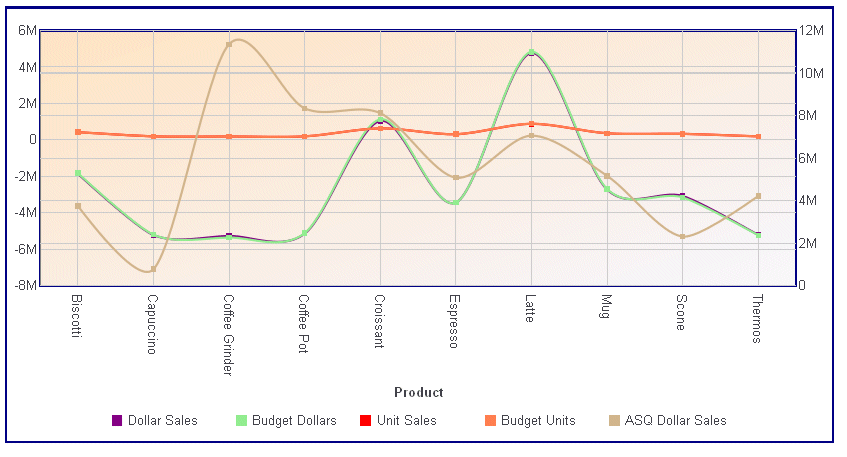chartFrame: {
fill: {
color: fillcolor },
border: {
width: number,
color: bordercolor,
dash: 'dstring'
},
shadow: shadowval}where:
- fillcolor
Is the fill color. Can be:
A color string, enclosed in single quotation marks, specifying a name or numeric specification string, or a gradient defined by a string. The default value is 'transparent'.
A JSON object that defines a gradient.
For information about specifying colors and gradients, see Colors and Gradients.
- number
Is the width of the frame border in pixels. The default value is zero (no border).
- bordercolor
Is the color of the border around the frame. Can be:
A color string, enclosed in single quotation marks, specifying a name or numeric specification string, or a gradient defined by a string. The default value is 'transparent'.
A JSON object that defines a gradient.
- 'dstring'
Is a string that defines the dash style of the border. The default value is '' (a solid line). Use a string of numbers that defines the width of a dash in pixels followed by the width of the gap between dashes in pixels (for example, dash: '1 1' draws a dotted line).
Multiple dashes can be defined within the string (for example, '2 4 4 2'), in which case, the dashes alternate around the border.
- shadowval
Enables or disables the shadow. Can be:
- true, which enables a default shadow on the chart frame.
- false, which disables a default shadow. The default value is false.
The following request against the GGSALES data source generates a chart frame whose fill color is antique white and whose border is a blue dashed line. It also generates a border that is a red dashed line with two different dash sizes that alternate around the border:
GRAPH FILE GGSALES
SUM DOLLARS UNITS
BY PRODUCT
ON GRAPH PCHOLD FORMAT JSCHART
ON GRAPH SET LOOKGRAPH VBAR
ON GRAPH SET STYLE *
*GRAPH_JS
title: {visible:true, text:"Blue Frame and Red Border", color:'green', font:'bold 14pt Sans-Serif'},
chartFrame: {
fill: {
color: 'antiquewhite'
},
border: {
width: 2,
color: 'blue',
dash: '2 2'
}
},
border: {
width: 4,
color: 'red',
dash: '2 4 4 2'
},
*END
INCLUDE=ENIADefault_combine.sty,$
ENDSTYLE
ENDThe output is

The following example applies a linear gradient fill to the chart frame that transitions from bisque to ghost white:
GRAPH FILE GGSALES
SUM DOLLARS BUDDOLLARS UNITS BUDUNITS ASQ.DOLLARS
ACROSS PRODUCT
ON GRAPH PCHOLD FORMAT JSCHART
ON GRAPH SET LOOKGRAPH LINE
ON GRAPH SET STYLE *
*GRAPH_JS
blaProperties: {lineConnection: 'curved'},
border: {
width: 2,
color: 'navy',
},
chartFrame: {
fill: {
color: {
type: 'linear',
start: {x: '0%', y: '0%'},
end: {x: '100%', y: '100%'},
stops: [
[0, 'bisque'],[1, 'ghostwhite'],
],
},
},
border: {
width: 2,
color: 'navy',
},
},
series: [
{series: 0, color: 'purple'},
{series: 1, color: 'lightgreen'},
{series: 2, color: 'red'},
{series: 3, color: 'coral'},
{series: 4, color: 'tan'}
]
*END
INCLUDE=ENIADefault_combine.sty,$
ENDSTYLE
ENDThe output is:
